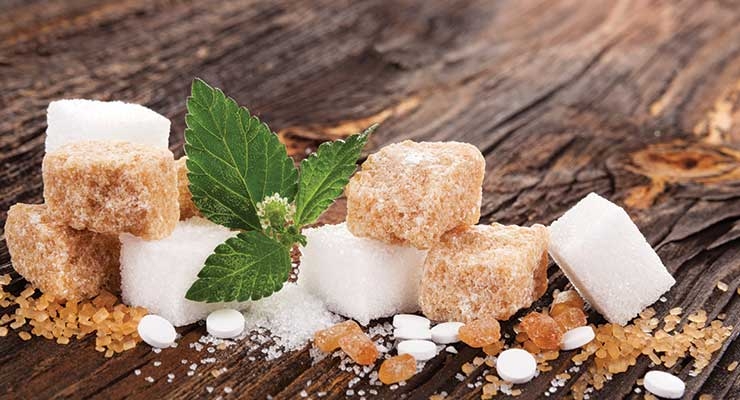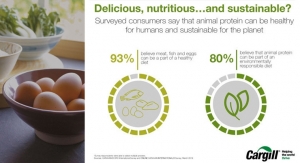By Lisa Olivo, Associate Editor06.03.19
Global obesity has nearly tripled since 1975, according to the World Health Organization, while the number of people with diabetes rose from 108 million in 1980 to 422 million in 2014. Scientists and medical professionals have linked these alarming health trends, as well as other health issues like metabolic syndrome, cardiovascular disease, and fatty liver, to increased sugar consumption, largely from added sugar in foods and sweet drinks.
Whereas sodium was once the “boogieman” of good health, sugar has stepped in to take its place. Market research from Mintel showed that 35% of U.S. consumers believe food and drink companies should be doing more to reduce the amount of sugar in products, while 34% also agreed companies should make it easier to understand how much sugar is in products (Mintel Sugar and Sweeteners – US, December 2016).
Some people are trying to cut out sugar altogether. Based on combined polls from 2014, 2015, and 2018, Gallup found that 51% of adults reported avoiding sugar. Older people (56% of those 65 and up, and 53% of those 50-64; compared to 30-49 at 52%, and 18-29 at 44%), Hispanics (55% compared to 50% of black, and 51% of white survey respondents); and college graduates (62%, compared to 47% of non-college grads) were all more likely to shun sugar.
“Consumers are paying closer attention to both sugar and artificial sweeteners in their products than ever before,” observed Julie Johnson, general manager, HealthFocus International. “Nearly half of U.S. shoppers (48%) said that ‘lower in sugar’ is extremely or very important on labels, an increase of 12 points since 2014. Conversely, 52% find ‘no artificial sweeteners’ equally as important and has seen nearly the same growth.”
Labeling & Regulation
Upcoming changes to the Nutrition Facts Label in the U.S. is one reason food and beverage manufacturers are clamoring to reel in sugar content. Based on the U.S. Food and Drug Administration’s (FDA) mandatory policy, added sugar content will need to be explicitly disclosed to consumers on product packaging. Set to take effect between 2020 and 2021, the new Nutrition Facts Label will reflect the grams and percent Daily Value (DV) of added sugar content, which would ideally help consumers limit calories from added sugar.
A recently published study in the journal Circulation suggested these updated labels could be a cost-effective way to boost Americans’ health, while financially benefitting the country’s healthcare system and society. Researchers suggested that added sugar labeling could prevent or postpone approximately 1 million cases of cardiometabolic disease—including heart disease, stroke, and type 2 diabetes—over a 20-year period. Furthermore, when paired with industry efforts to reduce sugar content in anticipation of the new labels, this number could be closer to 3 million.
Healthcare savings could also be significant. Added sugar labeling was estimated to save $31 billion in net healthcare costs and $61.9 billion in societal costs. Again, if food reformulation also reduced sugar content, the U.S. could save even more—$57.6 billion in net healthcare costs and $113.2 billion in societal costs.
Shaun Richmond, global vice president of sweeteners for Layn USA, Newport Beach, CA, sees these changes as a step in the right direction. “We believe that anything that allows consumers to stop and take a look at their overall diet and the foods and beverages that they consume is a positive step,” he said. Richmond perceived measures such as state sugar taxes, changes to the Nutrition Facts Label, and other regulatory measures around sugar consumption, as positive actions that will ultimately “increase consumer awareness and act as a catalyst for conversation around how consumers balance their own and their family’s diet.” In a culture where consumers are bombarded by convenient and indulgent foods and beverages, Richmond asserted “these measures can help to ensure nutrition and dietary balance remain part of the conversation.”
While these regulations are designed to support Americans in making more informed decisions about what they’re consuming, such changes can create “confusion and challenges for food manufacturers and marketers pertaining to ingredients selection,” said Amy Targan, president of Malt Products Corporation, a Saddle Brook, NJ-based manufacturer of malted barley extract and other natural sweeteners. While she stressed “the importance of balanced nutrition” Targan asserted that “all sweeteners aren’t created equal.” That said, she believes “sweeteners such as naturally derived grain extracts should be viewed differently by regulators in terms of the ‘added sugars’ label category, as these ingredients provide important nutrients above and
beyond flavoring.”
Discussing government intervention in sugar consumption, Andy Ohmes, global director of high intensity sweeteners for Cargill, Wayzata, MN, said “we all have a stake in improving consumer health, and if we work collectively to better understand the root causes that are driven by science, not unsubstantiated opinions, we can create transparent solutions that lead to sustained improvements in health.”
He called Nutrition Fact Labels an important source of information, and expressed support for “plans for public education and awareness activities that can help consumers understand the new labels and how to use them.”
Ohmes added, “The educational efforts put forth by the government agencies and other stakeholders will be equally critical to ensure what is put on the label translates into changing consumer behaviors.”
The Sugar Reduction Trend
Johnson of HealthFocus International called the category for sweeteners, including sugar, “the perfect storm of conflicting consumer needs.” Key issues impacting the space include the desire to reduce calories and carbohydrates, and reign in weight; the trend of clean eating and avoidance of artificial ingredients; consumer desire for formulas supporting sustained, natural energy (particularly among those with children); and above all, consumer demand for appealing taste experiences.
“Because of this, all sweeteners have been under intense consumer scrutiny, and unlike the low-sodium trend, which was relatively short-lived and non-transformational, the factors impacting sweeteners are creating significant and long-term changes in how consumers view and use these products,” explained Johnson.” She said these conflicting needs will drive consumer decisions at the shelf. “At a very basic level, even though they may not always act accordingly, sugar reduction is all about consumers trying to be healthier. According to the HealthFocus Global Sweetener Report, 95% of shoppers around the world believe that reducing sugar makes foods and beverages at least somewhat healthier, so it makes sense that this has also garnered the attention of manufacturers.”
The sugar alternatives that rated highest with consumers were natural ingredients such as honey and fruit juice, said Johnson, despite not necessarily being the most commonly used. Further representative of consumers’ conflicted mindsets surrounding sweetness, she observed “consumers say that they don’t always want a replacement sweetener, but rather products that are less sweet or use other non-sweet flavors, such as cucumber basil infused water, for example.”
Katharina Pueller, director of the natural sweetener business for Sweegen, Rancho Santa Margarita, CA, suggested consumers have become more aware of the detrimental effects of consuming too much sugar. “More and more, they are now checking ingredient labels for sugar content, and in the end choosing healthier products with lower added sugar content.” She said natural sweeteners are moving in to take sugar’s place.
The International Food Information Council 2018 Food & Health Survey study found that 77% of respondents were trying to limit or avoid sugars in general, noted Cargill’s Ohmes. “That same survey found six in 10 respondents view added sugars negatively,” he added. “Lifestyle trends focused on healthier choices and ‘clean’ eating, coupled with regulatory mandates and media messaging linking excessive sugar consumption to health concerns, are some of the key influencers driving the growing demand for sugar-reduction solutions.”
Despite consumers’ growing aversion to sugar, they nonetheless have an uncompromising demand for taste. Ohmes said for brands to be successful they must balance indulgence and appealing flavor with consumers’ growing enthusiasm for products with improved nutritional profiles.
“The consumption of added sugars by adults in the U.S. has increased by more than 30% over the last three decades,” said Richmond of Layn USA, citing a 2014 study published in Obesity Society. Meanwhile, data from the Centers for Disease Control and Prevention (CDC) indicate that during this same period the rate of obesity skyrocketed, with over 71% of the adult U.S. being either overweight or obese. “Many are drawing the conclusion that there is at least some correlation, whether strong or otherwise, between the increase in sugar intake and our growing problem of weight management,” stated Richmond. “Consumers more than ever are reading the labels of their foods and beverages with a wary eye for ingredients that they may not have focused on in the past. Sugar is increasingly at the top of that list.”
Climbing obesity rates in the U.S. and abroad have made empty calories from sugar and carbohydrates an “easy target for nutritionist, health policymakers, and NGOs,” commented Targan of Malt Products Corporation. She suggested that refined sugars and syrups can cause a variety of health issues, when by contrast “holistic natural sweeteners such as malt barley extracts provide proteins, vitamins, minerals, and antioxidants along with pleasant flavors and optimal, often less intense sweetness.” Additionally she suggested there is a growing awareness of and interest in functional sweeteners such as grain extracts and molasses due to their micronutrient content.
Natural vs. Artificial
In their quest to avoid sugar, consumers are seeking out natural or plant-based formulas to fill in the flavor gap. In general, consumers are more partial to easily identifiable, naturally-derived ingredients when compared with the complexly-named, lab-created synthetic formulas.
Market research from Mintel demonstrated this, as 35% of U.S. consumers agreed that artificial sweeteners are bad for health, while just 19% agreed that artificial sweeteners taste as good as sugar in food/drink products.
Furthermore, 26% of U.S. consumers said they would like to see more food/drinks which use naturally sourced sugar substitutes (such as stevia). Nineteen percent said they are purchasing more foods and drinks containing natural sweeteners such as monk fruit or stevia, while 16% said they would pay more for such products.
While consumer interest in naturally-sourced sweeteners has piqued, Richmond of Layn USA believes there will always be competition from artificial sweeteners. “Both options offer sugar and calorie reduction, which is important to a large number of consumers,” he said. “The balance has certainly shifted in recent years with most food and beverage companies acknowledging a consumer preference for a more natural product. While this is solid progress for both food and beverage companies and sweetener producers, plant-based sweeteners still have work ahead.”
He stressed the need for consumer education about the benefits of natural formulas, as a large portion of the general U.S. population is accustomed to artificial sweeteners. “They may not prefer them or actively search for products sweetened with artificial sweeteners, but they are accustomed to the taste profile and may even consume them regularly in their favorite foods and beverages.” Richmond said that while natural ingredients like stevia and monk fruit show great potential, there are still large numbers of consumers that have either never heard of them, or may have tried a product sweetened with them years ago when the taste profile didn’t deliver. “For this reason, suppliers and food and beverage companies must focus on educating consumers and ensuring that they experience the food and beverages showcasing stevia and monk fruit with the well-rounded sweetness that is now possible,” he urged. “When this is done well, we continue to see significant changes in consumer perception and product adoption over artificially sweetened products.”
Johnson of HealthFocus International said consumer health objectives are key factors when they are selecting a sugar replacement. “If they are cutting sugar to lose weight or reduce calorie intake, they may replace it with an artificial sweetener that is calorie free. However, if they are trying to substitute for a more natural alternative, they may reach for maple syrup or coconut palm sugar. Both natural sugar alternatives and artificial sweeteners still have a place, but knowing your audience is critical in deciding which direction to go in a product.”
In its USA Trend Study, HealthFocus asked consumers to rate a list of sweeteners as either “good,” “bad” or “neither good nor bad,” explained Johnson. “Good” ratings aren’t growing significantly, which she said is demonstrative of an overall negative perception of sweeteners. The top growth for “good” ratings was monk fruit, which was up by just four points. Other natural sweeteners that showed modest growth were lesser known and niche in the market. “‘Bad’ ratings for sweeteners has seen more growth in recent years—as more people are becoming aware of coconut palm sugar, a greater proportion feel it is ‘bad.’ Sugar has seen the second highest growth in negative rating with now 30% of consumers viewing it as ‘bad.’”
Among the key forces driving consumer demand for natural sweeteners is the concept of clean label, as well as calls for sugar reduction, observed Ohmes of Cargill. He said these trends show no sign of slowing down. “Consumers want reduced-sugar foods and beverages made with familiar ingredients—but not at the expense of great taste. Taste is, and will remain, the single biggest driver of purchase intent.” Fortunately, he suggested formulators have more tools available today than ever before, “as brands strive to balance consumers’ sometimes-competing-demands for products made with familiar, natural ingredients that offer improved nutritional profiles—all without sacrificing taste.”
Sweetness, Without Sugar
As more consumers express interest in natural sugar alternatives, the marketplace is presented with a variety of ingredients to meet specific sweetening needs.
“In addition to ingredients like stevia, agave, coconut palm sugar, and monk fruit, which are already nearing mainstream awareness, other natural-based sweeteners are emerging like syrups derived from dates, brown rice, yacon, and sorghum,” observed Johnson of HealthFocus International. She suggested a key advantage of many of these ingredients is that most consumers would not object to their inclusion on Nutrition Facts Labels, as they are natural and recognizable, and therefore considered “safe.” However, Johnson said issues such as cost, product formulation, and taste issues have prevented them from truly going mainstream. “What we see in the near and intermediate term are consumers changing their habits by choosing less sweet or other flavors,” she predicted.
Data from Mintel showed erythritol was on the rise, with food and drink launches including the ingredient doubling between June 2012 and May 2017. As an example, researchers pointed to the popularity of Halo Top ice cream as a product turning to natural sweeteners like erythritol in a successful way. The brand promotes itself as a low-sugar, low-calorie, clean label confectionery. Its website explained the formulation by promoting its use of “organic stevia…that’s native to Paraguay” along with “erythritol, which though it has a rather scientific-sounding name, is actually another all-natural sweetener found in fruits like pears and grapes.” Halo Top goes on to specify that while erythritol is “technically a sugar alcohol, it’s unlike the others because…[it] doesn’t affect blood glucose or cause bloating.”
Mintel also found consumers favoring stevia, particularly within the juice category. The market research firm found purchase intent was higher with juice drinks with stevia (36%) compared to all juice drinks (32%). Those aged 18-34 were most likely to purchase stevia-sweetened juice (49%), followed by 37% of 35-54 year olds, and 28% of consumers 55+. With fruit juice sales slumping in recent years due to high sugar content and perceptions of unhealthiness, this could be an opportunity for manufacturers.
Mintel also found increased interest in xylitol, as marketers have begun promoting its plant-based origins. The research firm explained the ingredient can be processed from trees, such as birch trees and other hardwoods; or created by an industrial process that converts the plant fiber xylan into xylitol. Mintel suggested that labeling terminology linking the ingredient back to its natural source could appeal to health-conscious consumers.
Food scientists at the University of Illinois recently discovered a strain of yeast that can metabolize lactose, the sugar in dairy products, into tagatose. Tagatose can be used as a natural sweetener, which provides less than half the calories of table sugar. Published in the journal Nature Communications, the study from professor of food science and human nutrition Yong-Su Jin explained “Tagatose is a sweetener that exhibits almost identical tastes and textures of sucrose, or table sugar. However, tagatose has many fewer calories than sucrose—about 40% of sucrose. In addition, it does not increase blood glucose levels as much as sucrose or fructose.”
Targan of Malt Products Corporation pointed to the success of non-caloric or low-calorie sweeteners such as allulose, isomalto-oligosaccharides, and hydrolyzed fibers. “They help provide control of added sugar and calories in food where they are used,” she explained. “However, it must be said that consumers are increasingly interested in pantry-friendly ingredients, meaning they’ll lean toward sweeteners whose names seem rooted in nature rather than a laboratory.”
Targan added that stevia, monk fruit, and inulin are popular, however, careful flavor considerations must be made when formulating with these ingredients. “They are suitable choices in some applications, but typically cannot fully stand up as an ideal substitute,” she explained. For example, stevia and monk fruit don’t “provide bulking, binding, and stability benefits in baked goods,” while in other goods, “the flavor profile simply isn’t comparable.”
Sweegen offers the stevia sweetener, Bestevia e+, which is a blend of different stevia molecules. “This blend contains a rare steviol glycoside called Reb E, which gives it a very special sugar-like taste,” explained Pueller. “This blend was created for beverages but really tastes great in all applications.”
Cargill, in a joint partnership with DSM under the name Avansya, developed EverSweet, a stevia formula that aims to provide sweetness without bitterness or a licorice aftertaste commonly associated with the sweetener. Ohmes said EverSweet sweetener allows food and beverage makers to “create great-tasting products with even deeper calorie reductions.” The ingredient offers “a more rounded taste profile with a faster onset of sweetness,” and enables up to 100% sugar replacement.
“In developing EverSweet, our scientists invested more than 300,000 hours studying the stevia leaf, searching for the optimal balance of sweetness and taste,” explained Ohmes. “Through this research, they found that two glycosides in the stevia plant, Reb M and Reb D, offered heightened sweetness and a taste closer to real sugar. While these glycosides are rare in the stevia plant, we produce them through fermentation.”
Ohmes said Cargill believes stevia and erythritol, often used in combination, are two of the best tools currently available for sugar reduction, across food and beverage applications. “Erythritol, which looks and tastes like sugar, is often paired with high-intensity sweeteners because it has a sugar-like aftertaste, and helps mask off-notes and replaces sugar’s bulk,”
he explained.
Meanwhile stevia product launches reached more than 4,300 new products globally in 2017, according to Innova Market Insights data. “Consumers’ positive perceptions of the plant-based sweetener clearly contributed to that growth,” said Ohmes. “According to Cargill’s proprietary online research of 13,000 consumers, when compared to 12 of the leading low/no calorie sweeteners, consumers ranked stevia leaf extract as the most healthful, as well as having the most positive perception on the label.”
Richmond of Layn USA said sweetener platforms using a combination of steviol glycosides and monk fruit’s mogrosides offer significant promise. Blended formulas such as this “have changed what is now possible in sweetener solutions for food and beverages with significantly reduced or zero sugar, and no artificial sweeteners.” He noted that products using a blend of these sweeteners are able to more closely mirror a sugar-like sweetness. “Other sweetener products that have seen a significant increase in interest recently include monk fruit juice concentrate, which has launched in a number of noteworthy brands in the last year.”
Flavor Obstacles
Non-sugar sweeteners—even natural ones—possess different strengths and weaknesses when it comes to formulating foods and beverages.
“Each sweetener has its own characteristics,” explained Richmond, “and a talented formulator can come very close to replicating that sugar-like sweetness and mouthfeel.” He stressed that formulators need to recognize the advantages and limitations of each sweetener in order to capitalize on potential flavor synergies. “This requires a significant investment of time and resources if you’re not working with the right provider that offers a sweetener platform designed for specific applications,” he cautioned.
Targan of Malt Products Corporation said the main challenge will always be taste. Others issues include “functionality benefits such as binding, bulking, and water activity control; environment and sustainability impact; and ‘pantry friendliness’ (i.e., easily recognizable ingredients), which can be a real problem, especially for non-natural sugar alternatives.”
Ohmes of Cargill suggested reformulating existing food and drink recipes to reduce sugar can be difficult. “Reformulation of foods and beverages to reduce sugar without sacrificing flavor, physical and textural attributes, cost, functionality, sustainability, and addressing the clean trend is challenging.” The reality, he said, is that sugar plays many roles. “In addition to providing sweetness, it also acts as a preservative—helping to extend the shelf life of foods and as a fermentation substrate. It is also important in the texture, structure, color, mouthfeel, viscosity, and flavoring of foods.” These are all reasons why reformulation for reduced sugar is such a challenge. “It doesn’t simply involve the removal of a single nutrient and, in fact, more often than not, the nutrient removed will have to be replaced with other ingredients.”
Innovation Outlook
As the market evolves, HealthFocus International expects the growing desire for personalized formulas will influence the sweetener market. “One of the important transformational areas that is yet to be fully developed is personalization that consumers seek to individualize for health, taste, and control,” said Johnson. “We see this as a potential new avenue that manufacturers can leverage to their benefit.”
Targan of Malt Products Corporation suggested clean label was a top priority moving forward, as the “sweeteners of tomorrow need to portray a wholesome image and a simple, even
throwback process.”
Cargill’s Ohmes believes consumer demand for reduced sugar options is just getting started, however the importance of taste and flavor experience must not be overlooked by formulators. He predicted foods and beverages that can achieve significant sugar reduction with the assistance of familiar and appealing ingredients would be successful—so long as they “still deliver on taste.”
Whereas sodium was once the “boogieman” of good health, sugar has stepped in to take its place. Market research from Mintel showed that 35% of U.S. consumers believe food and drink companies should be doing more to reduce the amount of sugar in products, while 34% also agreed companies should make it easier to understand how much sugar is in products (Mintel Sugar and Sweeteners – US, December 2016).
Some people are trying to cut out sugar altogether. Based on combined polls from 2014, 2015, and 2018, Gallup found that 51% of adults reported avoiding sugar. Older people (56% of those 65 and up, and 53% of those 50-64; compared to 30-49 at 52%, and 18-29 at 44%), Hispanics (55% compared to 50% of black, and 51% of white survey respondents); and college graduates (62%, compared to 47% of non-college grads) were all more likely to shun sugar.
“Consumers are paying closer attention to both sugar and artificial sweeteners in their products than ever before,” observed Julie Johnson, general manager, HealthFocus International. “Nearly half of U.S. shoppers (48%) said that ‘lower in sugar’ is extremely or very important on labels, an increase of 12 points since 2014. Conversely, 52% find ‘no artificial sweeteners’ equally as important and has seen nearly the same growth.”
Labeling & Regulation
Upcoming changes to the Nutrition Facts Label in the U.S. is one reason food and beverage manufacturers are clamoring to reel in sugar content. Based on the U.S. Food and Drug Administration’s (FDA) mandatory policy, added sugar content will need to be explicitly disclosed to consumers on product packaging. Set to take effect between 2020 and 2021, the new Nutrition Facts Label will reflect the grams and percent Daily Value (DV) of added sugar content, which would ideally help consumers limit calories from added sugar.
A recently published study in the journal Circulation suggested these updated labels could be a cost-effective way to boost Americans’ health, while financially benefitting the country’s healthcare system and society. Researchers suggested that added sugar labeling could prevent or postpone approximately 1 million cases of cardiometabolic disease—including heart disease, stroke, and type 2 diabetes—over a 20-year period. Furthermore, when paired with industry efforts to reduce sugar content in anticipation of the new labels, this number could be closer to 3 million.
Healthcare savings could also be significant. Added sugar labeling was estimated to save $31 billion in net healthcare costs and $61.9 billion in societal costs. Again, if food reformulation also reduced sugar content, the U.S. could save even more—$57.6 billion in net healthcare costs and $113.2 billion in societal costs.
Shaun Richmond, global vice president of sweeteners for Layn USA, Newport Beach, CA, sees these changes as a step in the right direction. “We believe that anything that allows consumers to stop and take a look at their overall diet and the foods and beverages that they consume is a positive step,” he said. Richmond perceived measures such as state sugar taxes, changes to the Nutrition Facts Label, and other regulatory measures around sugar consumption, as positive actions that will ultimately “increase consumer awareness and act as a catalyst for conversation around how consumers balance their own and their family’s diet.” In a culture where consumers are bombarded by convenient and indulgent foods and beverages, Richmond asserted “these measures can help to ensure nutrition and dietary balance remain part of the conversation.”
While these regulations are designed to support Americans in making more informed decisions about what they’re consuming, such changes can create “confusion and challenges for food manufacturers and marketers pertaining to ingredients selection,” said Amy Targan, president of Malt Products Corporation, a Saddle Brook, NJ-based manufacturer of malted barley extract and other natural sweeteners. While she stressed “the importance of balanced nutrition” Targan asserted that “all sweeteners aren’t created equal.” That said, she believes “sweeteners such as naturally derived grain extracts should be viewed differently by regulators in terms of the ‘added sugars’ label category, as these ingredients provide important nutrients above and
beyond flavoring.”
Discussing government intervention in sugar consumption, Andy Ohmes, global director of high intensity sweeteners for Cargill, Wayzata, MN, said “we all have a stake in improving consumer health, and if we work collectively to better understand the root causes that are driven by science, not unsubstantiated opinions, we can create transparent solutions that lead to sustained improvements in health.”
He called Nutrition Fact Labels an important source of information, and expressed support for “plans for public education and awareness activities that can help consumers understand the new labels and how to use them.”
Ohmes added, “The educational efforts put forth by the government agencies and other stakeholders will be equally critical to ensure what is put on the label translates into changing consumer behaviors.”
The Sugar Reduction Trend
Johnson of HealthFocus International called the category for sweeteners, including sugar, “the perfect storm of conflicting consumer needs.” Key issues impacting the space include the desire to reduce calories and carbohydrates, and reign in weight; the trend of clean eating and avoidance of artificial ingredients; consumer desire for formulas supporting sustained, natural energy (particularly among those with children); and above all, consumer demand for appealing taste experiences.
“Because of this, all sweeteners have been under intense consumer scrutiny, and unlike the low-sodium trend, which was relatively short-lived and non-transformational, the factors impacting sweeteners are creating significant and long-term changes in how consumers view and use these products,” explained Johnson.” She said these conflicting needs will drive consumer decisions at the shelf. “At a very basic level, even though they may not always act accordingly, sugar reduction is all about consumers trying to be healthier. According to the HealthFocus Global Sweetener Report, 95% of shoppers around the world believe that reducing sugar makes foods and beverages at least somewhat healthier, so it makes sense that this has also garnered the attention of manufacturers.”
The sugar alternatives that rated highest with consumers were natural ingredients such as honey and fruit juice, said Johnson, despite not necessarily being the most commonly used. Further representative of consumers’ conflicted mindsets surrounding sweetness, she observed “consumers say that they don’t always want a replacement sweetener, but rather products that are less sweet or use other non-sweet flavors, such as cucumber basil infused water, for example.”
Katharina Pueller, director of the natural sweetener business for Sweegen, Rancho Santa Margarita, CA, suggested consumers have become more aware of the detrimental effects of consuming too much sugar. “More and more, they are now checking ingredient labels for sugar content, and in the end choosing healthier products with lower added sugar content.” She said natural sweeteners are moving in to take sugar’s place.
The International Food Information Council 2018 Food & Health Survey study found that 77% of respondents were trying to limit or avoid sugars in general, noted Cargill’s Ohmes. “That same survey found six in 10 respondents view added sugars negatively,” he added. “Lifestyle trends focused on healthier choices and ‘clean’ eating, coupled with regulatory mandates and media messaging linking excessive sugar consumption to health concerns, are some of the key influencers driving the growing demand for sugar-reduction solutions.”
Despite consumers’ growing aversion to sugar, they nonetheless have an uncompromising demand for taste. Ohmes said for brands to be successful they must balance indulgence and appealing flavor with consumers’ growing enthusiasm for products with improved nutritional profiles.
“The consumption of added sugars by adults in the U.S. has increased by more than 30% over the last three decades,” said Richmond of Layn USA, citing a 2014 study published in Obesity Society. Meanwhile, data from the Centers for Disease Control and Prevention (CDC) indicate that during this same period the rate of obesity skyrocketed, with over 71% of the adult U.S. being either overweight or obese. “Many are drawing the conclusion that there is at least some correlation, whether strong or otherwise, between the increase in sugar intake and our growing problem of weight management,” stated Richmond. “Consumers more than ever are reading the labels of their foods and beverages with a wary eye for ingredients that they may not have focused on in the past. Sugar is increasingly at the top of that list.”
Climbing obesity rates in the U.S. and abroad have made empty calories from sugar and carbohydrates an “easy target for nutritionist, health policymakers, and NGOs,” commented Targan of Malt Products Corporation. She suggested that refined sugars and syrups can cause a variety of health issues, when by contrast “holistic natural sweeteners such as malt barley extracts provide proteins, vitamins, minerals, and antioxidants along with pleasant flavors and optimal, often less intense sweetness.” Additionally she suggested there is a growing awareness of and interest in functional sweeteners such as grain extracts and molasses due to their micronutrient content.
Natural vs. Artificial
In their quest to avoid sugar, consumers are seeking out natural or plant-based formulas to fill in the flavor gap. In general, consumers are more partial to easily identifiable, naturally-derived ingredients when compared with the complexly-named, lab-created synthetic formulas.
Market research from Mintel demonstrated this, as 35% of U.S. consumers agreed that artificial sweeteners are bad for health, while just 19% agreed that artificial sweeteners taste as good as sugar in food/drink products.
Furthermore, 26% of U.S. consumers said they would like to see more food/drinks which use naturally sourced sugar substitutes (such as stevia). Nineteen percent said they are purchasing more foods and drinks containing natural sweeteners such as monk fruit or stevia, while 16% said they would pay more for such products.
While consumer interest in naturally-sourced sweeteners has piqued, Richmond of Layn USA believes there will always be competition from artificial sweeteners. “Both options offer sugar and calorie reduction, which is important to a large number of consumers,” he said. “The balance has certainly shifted in recent years with most food and beverage companies acknowledging a consumer preference for a more natural product. While this is solid progress for both food and beverage companies and sweetener producers, plant-based sweeteners still have work ahead.”
He stressed the need for consumer education about the benefits of natural formulas, as a large portion of the general U.S. population is accustomed to artificial sweeteners. “They may not prefer them or actively search for products sweetened with artificial sweeteners, but they are accustomed to the taste profile and may even consume them regularly in their favorite foods and beverages.” Richmond said that while natural ingredients like stevia and monk fruit show great potential, there are still large numbers of consumers that have either never heard of them, or may have tried a product sweetened with them years ago when the taste profile didn’t deliver. “For this reason, suppliers and food and beverage companies must focus on educating consumers and ensuring that they experience the food and beverages showcasing stevia and monk fruit with the well-rounded sweetness that is now possible,” he urged. “When this is done well, we continue to see significant changes in consumer perception and product adoption over artificially sweetened products.”
Johnson of HealthFocus International said consumer health objectives are key factors when they are selecting a sugar replacement. “If they are cutting sugar to lose weight or reduce calorie intake, they may replace it with an artificial sweetener that is calorie free. However, if they are trying to substitute for a more natural alternative, they may reach for maple syrup or coconut palm sugar. Both natural sugar alternatives and artificial sweeteners still have a place, but knowing your audience is critical in deciding which direction to go in a product.”
In its USA Trend Study, HealthFocus asked consumers to rate a list of sweeteners as either “good,” “bad” or “neither good nor bad,” explained Johnson. “Good” ratings aren’t growing significantly, which she said is demonstrative of an overall negative perception of sweeteners. The top growth for “good” ratings was monk fruit, which was up by just four points. Other natural sweeteners that showed modest growth were lesser known and niche in the market. “‘Bad’ ratings for sweeteners has seen more growth in recent years—as more people are becoming aware of coconut palm sugar, a greater proportion feel it is ‘bad.’ Sugar has seen the second highest growth in negative rating with now 30% of consumers viewing it as ‘bad.’”
Among the key forces driving consumer demand for natural sweeteners is the concept of clean label, as well as calls for sugar reduction, observed Ohmes of Cargill. He said these trends show no sign of slowing down. “Consumers want reduced-sugar foods and beverages made with familiar ingredients—but not at the expense of great taste. Taste is, and will remain, the single biggest driver of purchase intent.” Fortunately, he suggested formulators have more tools available today than ever before, “as brands strive to balance consumers’ sometimes-competing-demands for products made with familiar, natural ingredients that offer improved nutritional profiles—all without sacrificing taste.”
Sweetness, Without Sugar
As more consumers express interest in natural sugar alternatives, the marketplace is presented with a variety of ingredients to meet specific sweetening needs.
“In addition to ingredients like stevia, agave, coconut palm sugar, and monk fruit, which are already nearing mainstream awareness, other natural-based sweeteners are emerging like syrups derived from dates, brown rice, yacon, and sorghum,” observed Johnson of HealthFocus International. She suggested a key advantage of many of these ingredients is that most consumers would not object to their inclusion on Nutrition Facts Labels, as they are natural and recognizable, and therefore considered “safe.” However, Johnson said issues such as cost, product formulation, and taste issues have prevented them from truly going mainstream. “What we see in the near and intermediate term are consumers changing their habits by choosing less sweet or other flavors,” she predicted.
Data from Mintel showed erythritol was on the rise, with food and drink launches including the ingredient doubling between June 2012 and May 2017. As an example, researchers pointed to the popularity of Halo Top ice cream as a product turning to natural sweeteners like erythritol in a successful way. The brand promotes itself as a low-sugar, low-calorie, clean label confectionery. Its website explained the formulation by promoting its use of “organic stevia…that’s native to Paraguay” along with “erythritol, which though it has a rather scientific-sounding name, is actually another all-natural sweetener found in fruits like pears and grapes.” Halo Top goes on to specify that while erythritol is “technically a sugar alcohol, it’s unlike the others because…[it] doesn’t affect blood glucose or cause bloating.”
Mintel also found consumers favoring stevia, particularly within the juice category. The market research firm found purchase intent was higher with juice drinks with stevia (36%) compared to all juice drinks (32%). Those aged 18-34 were most likely to purchase stevia-sweetened juice (49%), followed by 37% of 35-54 year olds, and 28% of consumers 55+. With fruit juice sales slumping in recent years due to high sugar content and perceptions of unhealthiness, this could be an opportunity for manufacturers.
Mintel also found increased interest in xylitol, as marketers have begun promoting its plant-based origins. The research firm explained the ingredient can be processed from trees, such as birch trees and other hardwoods; or created by an industrial process that converts the plant fiber xylan into xylitol. Mintel suggested that labeling terminology linking the ingredient back to its natural source could appeal to health-conscious consumers.
Food scientists at the University of Illinois recently discovered a strain of yeast that can metabolize lactose, the sugar in dairy products, into tagatose. Tagatose can be used as a natural sweetener, which provides less than half the calories of table sugar. Published in the journal Nature Communications, the study from professor of food science and human nutrition Yong-Su Jin explained “Tagatose is a sweetener that exhibits almost identical tastes and textures of sucrose, or table sugar. However, tagatose has many fewer calories than sucrose—about 40% of sucrose. In addition, it does not increase blood glucose levels as much as sucrose or fructose.”
Targan of Malt Products Corporation pointed to the success of non-caloric or low-calorie sweeteners such as allulose, isomalto-oligosaccharides, and hydrolyzed fibers. “They help provide control of added sugar and calories in food where they are used,” she explained. “However, it must be said that consumers are increasingly interested in pantry-friendly ingredients, meaning they’ll lean toward sweeteners whose names seem rooted in nature rather than a laboratory.”
Targan added that stevia, monk fruit, and inulin are popular, however, careful flavor considerations must be made when formulating with these ingredients. “They are suitable choices in some applications, but typically cannot fully stand up as an ideal substitute,” she explained. For example, stevia and monk fruit don’t “provide bulking, binding, and stability benefits in baked goods,” while in other goods, “the flavor profile simply isn’t comparable.”
Sweegen offers the stevia sweetener, Bestevia e+, which is a blend of different stevia molecules. “This blend contains a rare steviol glycoside called Reb E, which gives it a very special sugar-like taste,” explained Pueller. “This blend was created for beverages but really tastes great in all applications.”
Cargill, in a joint partnership with DSM under the name Avansya, developed EverSweet, a stevia formula that aims to provide sweetness without bitterness or a licorice aftertaste commonly associated with the sweetener. Ohmes said EverSweet sweetener allows food and beverage makers to “create great-tasting products with even deeper calorie reductions.” The ingredient offers “a more rounded taste profile with a faster onset of sweetness,” and enables up to 100% sugar replacement.
“In developing EverSweet, our scientists invested more than 300,000 hours studying the stevia leaf, searching for the optimal balance of sweetness and taste,” explained Ohmes. “Through this research, they found that two glycosides in the stevia plant, Reb M and Reb D, offered heightened sweetness and a taste closer to real sugar. While these glycosides are rare in the stevia plant, we produce them through fermentation.”
Ohmes said Cargill believes stevia and erythritol, often used in combination, are two of the best tools currently available for sugar reduction, across food and beverage applications. “Erythritol, which looks and tastes like sugar, is often paired with high-intensity sweeteners because it has a sugar-like aftertaste, and helps mask off-notes and replaces sugar’s bulk,”
he explained.
Meanwhile stevia product launches reached more than 4,300 new products globally in 2017, according to Innova Market Insights data. “Consumers’ positive perceptions of the plant-based sweetener clearly contributed to that growth,” said Ohmes. “According to Cargill’s proprietary online research of 13,000 consumers, when compared to 12 of the leading low/no calorie sweeteners, consumers ranked stevia leaf extract as the most healthful, as well as having the most positive perception on the label.”
Richmond of Layn USA said sweetener platforms using a combination of steviol glycosides and monk fruit’s mogrosides offer significant promise. Blended formulas such as this “have changed what is now possible in sweetener solutions for food and beverages with significantly reduced or zero sugar, and no artificial sweeteners.” He noted that products using a blend of these sweeteners are able to more closely mirror a sugar-like sweetness. “Other sweetener products that have seen a significant increase in interest recently include monk fruit juice concentrate, which has launched in a number of noteworthy brands in the last year.”
Flavor Obstacles
Non-sugar sweeteners—even natural ones—possess different strengths and weaknesses when it comes to formulating foods and beverages.
“Each sweetener has its own characteristics,” explained Richmond, “and a talented formulator can come very close to replicating that sugar-like sweetness and mouthfeel.” He stressed that formulators need to recognize the advantages and limitations of each sweetener in order to capitalize on potential flavor synergies. “This requires a significant investment of time and resources if you’re not working with the right provider that offers a sweetener platform designed for specific applications,” he cautioned.
Targan of Malt Products Corporation said the main challenge will always be taste. Others issues include “functionality benefits such as binding, bulking, and water activity control; environment and sustainability impact; and ‘pantry friendliness’ (i.e., easily recognizable ingredients), which can be a real problem, especially for non-natural sugar alternatives.”
Ohmes of Cargill suggested reformulating existing food and drink recipes to reduce sugar can be difficult. “Reformulation of foods and beverages to reduce sugar without sacrificing flavor, physical and textural attributes, cost, functionality, sustainability, and addressing the clean trend is challenging.” The reality, he said, is that sugar plays many roles. “In addition to providing sweetness, it also acts as a preservative—helping to extend the shelf life of foods and as a fermentation substrate. It is also important in the texture, structure, color, mouthfeel, viscosity, and flavoring of foods.” These are all reasons why reformulation for reduced sugar is such a challenge. “It doesn’t simply involve the removal of a single nutrient and, in fact, more often than not, the nutrient removed will have to be replaced with other ingredients.”
Innovation Outlook
As the market evolves, HealthFocus International expects the growing desire for personalized formulas will influence the sweetener market. “One of the important transformational areas that is yet to be fully developed is personalization that consumers seek to individualize for health, taste, and control,” said Johnson. “We see this as a potential new avenue that manufacturers can leverage to their benefit.”
Targan of Malt Products Corporation suggested clean label was a top priority moving forward, as the “sweeteners of tomorrow need to portray a wholesome image and a simple, even
throwback process.”
Cargill’s Ohmes believes consumer demand for reduced sugar options is just getting started, however the importance of taste and flavor experience must not be overlooked by formulators. He predicted foods and beverages that can achieve significant sugar reduction with the assistance of familiar and appealing ingredients would be successful—so long as they “still deliver on taste.”






















